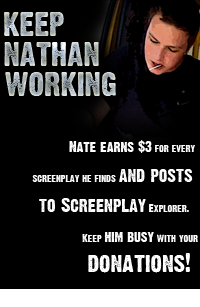February 7th, 2010 · Comments Off
A paragraph from Napoleon Hill’s famous book “Think and Grow Rich. ”
”
“Sex desire is the most powerful of human desires. When driven by this desire, men develop keenness of imagination, courage, will-power, persistence, and creative ability unknown to them at other times. So strong and impelling is the desire for sexual contact that men freely run the risk of life and reputation to indulge it. When harnessed, and redirected along other lines, this motivating force maintains all of its attributes of keenness of imagination, courage, etc., which may be used as powerful creative forces in literature, art, or in any other profession or calling, including, of course, the accumulation of riches.”
Exercise will-power and “transmute” your sex energy into untapped creative genius!

Tags: · Napoleon Hill, screenwriting, Think and Grow Rich, writing tips
August 7th, 2009 · 1 Comment
I’ve always had a problem with present tense and past tense. Even in this article I’m sure I’ll shift back and forth without being aware of it. Screenplays are supposed to be written in present tense. I didn’t know this until someone working in the industry brought it glaringly to my attention.
So if you’re like me and can’t grasp the difference between present and past tense, here’s a trick. Kill the ings. If a word ends with “ing”, it’s probably past tense. This is not always the case, but 90% of the time it is.
Example:
Past Tense
“Jack was leaning against a wall. Jill was walking past with a tray of biscuits and Jack stuck out his leg and ended up tripping her, sending her tumbling down a stairwell.”
Present Tense
“Jack leans against a wall. Jill walks past with a tray of biscuits and Jack sticks out a leg and trips her. She tumbles down a stairwell.”
The neat thing about present tense is it gives your story punch and can lead to a more engaging writing style. You can even write short, choppy sentences…
“Jill glares upward. Looks pissed. Grabs the tray and Frisbee’s it at Jack’s head.”
So grab your script and start kill-ing.

Tags: · ing, screenplay present tense
May 22nd, 2009 · Comments Off
By Raisy Roo
A “quick read” simply means painting your scenes with a minimum of words, and the trick is to not lose anything in the process.
Just as the director and film editors’ job is to cut scenes that aren’t necessary to convey the story, your job screenwriting is to remove words that aren’t necessary to convey the story. If you’re good, you can do this along the way. If you’re like me, you’ll have to go back (repeatedly) and find the areas that can be “quickened.”
The action in the paragraph below is an example of a slow read, if you will.
“Jack sits down in the chair and removes his wedding ring from his finger. A waiter is passing by and Jack decides to drop the ring into a bowl of milky white soup on the waiter’s tray. “
From the scene heading in your script, the reader should already know we’re in a restaurant. Chairs are pretty common in a restaurant, so when Jack sits he is most likely sitting in a chair. The reader is also probably aware that most people wear wedding rings on their finger. The last line relating to the waiter is simply better served abbreviated.
A more effective way to describe the scene may be like this…
“Jack sits. Tugs at his wedding ring. Drops it in a passing waiter’s clam chowder.”
Or, if you’re more traditional…
“Jack sits. He tugs at his wedding ring and drops it in a passing waiter’s clam chowder.”
Turn your script into a lean, mean, money making machine by making it a quick read.

Tags: · quick read, screenwriting, screenwriting tips
![]() ”
”




